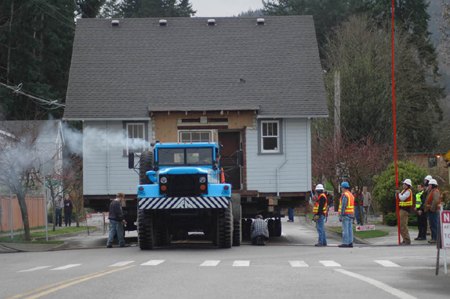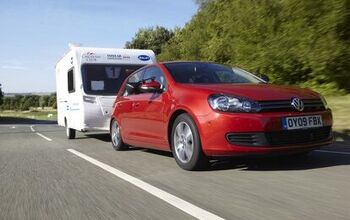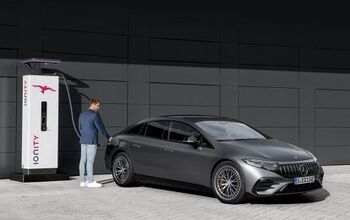The Great American Anti-Towing Conspiracy

“Scion does not recommend towing a trailer… your vehicle was not designed for towing.” Welcome to the great American anti-towing conspiracy. Manufacturers of anything less than a big SUV or pick-up are trying to take away our God-given right to tow with our cars. For a guy who’s towed everything from a Radio Flyer wagon behind a pedal-powered John Deere sidewalk tractor, to a three-bedroom house, I feel like I’m being singled out. Of course, there’s a possibility that I’m the cause as well as the target of this jihad. A lot of lawyers do drive the Ventura Freeway, and one of them may well have seen my spectacular stunt with a trailer.
Before I recount the creative maneuver with which I simultaneously occupied all four lanes of “the world’s busiest freeway” at sixty-five mph, let’s look at the prejudice American would-be towers are up against …
On Toyota’s UK website, the Yaris is credited with a towing capacity of 1050kg/2315lbs. That’s right in line with the old rule of thumb that a car can safely tow an amount equal to its own weight.
But here in the land of the (not so) free, the Yaris’ owner’s manual admonishes: “Toyota does not recommend towing a trailer with your vehicle.” The unnamed author goes on to give a partial pass to our northern neighbors: “In Canada only, total weight of cargo and trailer not to exceed 700lbs.” Please leave your trailers at the border? Perhaps this partial exemption reflects Canada’s status as being somewhere between English and American. But the logic is lost on me.
Maybe it’s a blatant tactic by Toyota to meet Tundra sales goals, by forcing us tow-heads into buying that over-achieving tug (rated for 10,000+lbs). But Honda is in on the conspiracy too. The CRV weighs 3600lbs and offers 166hp, about the same as an old gen Explorer. In Europe, where folks often buy CUV’s specifically for their towing capacity, the CRV is rated to tow 2000kg/4400lbs. And in the tow-aphobic US? A measly 1500lbs!
It wasn’t always like this. In the sixties, you’d see 40hp VW Beetles pulling a trailer. In 1976, my VW Beetle died in Ohio heading back to Iowa, so we left it and hitch-hiked the rest of the way. My girlfriend’s Mom was driving a 70hp Corolla, which was rated to tow 1800lbs, exactly the weight of my VW. She generously offered it. Towing the Bug home, the Corolla never broke a sweat.
Which I can’t say for myself when I nearly shut down the 101.
It was 1986. We had just bought our first house, in Woodland Hills. I rented a big double-axle twelve-foot trailer to haul debris and junk to the dump. My Mexican helper was a zealous worker, loading lots of broken concrete into the back end of the trailer. I remember glancing at the warning sign about having 60 percent of the weight ahead of the axles. But any fleeting thought of relevancy or concern was quickly overpowered by the testosterone-fueled urge to PULL!
That trailer must have weighed about three times as much as the Jeep Cherokee tug. I managed to squeeze into the perpetually crowded Ventura freeway.
When our rig (finally) hit 65 in the right lane, the trailer began oscillating, which escalated exponentially. The next thing I knew, the Jeep was being swung wildly from side to side, like the tail on a dog. One moment, we were facing towards the shoulder, then across all the lanes facing the center divider. The Jeep was utterly out of control; there was nothing to do but hang on for dear life, waiting for the fishtailing trailer to roll and/or get creamed by the four lanes of traffic behind us.
Fortunately, the other drivers (and that corporate attorney) were on the ball and held back, in awe of our mad gyrations. When enough speed was scrubbed off and stability resumed, we found ourselves in the narrow left shoulder, where we sat bathed in sweat.
I had no choice but to steel myself, get back in the traffic, and fight my way across four lanes while keeping the speed below fifty. When we finally pulled off on the right shoulder, my ashen-faced helper tumbled out, got on his knees and crossed himself, before we started re-arranging the trailer’s load.
Having learned that cardinal lesson of towing, I’m a hair more cautious now. But I still believe that cars, by their nature, are “designed for towing.” So I always carry a tow rope in the old Ford pick-up instead of an AAA card. More than once, Stephanie has schlepped me home with the Forester. I don’t even want to know what its tow rating is; it’s survived just fine. And I’ve found an after-market hitch for the xB, rated for 2000lbs.

More by Paul Niedermeyer
Latest Car Reviews
Read moreLatest Product Reviews
Read moreRecent Comments
- Jeff JMII--If I did not get my Maverick my next choice was a Santa Cruz. They are different but then they are both compact pickups the only real compact pickups on the market. I am glad to hear that the Santa Cruz will have knobs and buttons on it for 2025 it would be good if they offered a hybrid as well. When I looked at both trucks it was less about brand loyalty and more about price, size, and features. I have owned 2 gm made trucks in the past and liked both but gm does not make a true compact truck and neither does Ram, Toyota, or Nissan. The Maverick was the only Ford product that I wanted. If I wanted a larger truck I would have kept either my 99 S-10 extended cab with a 2.2 I-4 5 speed or my 08 Isuzu I-370 4 x 4 with the 3.7 I-5, tow package, heated leather seats, and other niceties and it road like a luxury vehicle. I believe the demand is there for other manufacturers to make compact pickups. The proposed hybrid Toyota Stout would be a great truck. Subaru has experience making small trucks and they could make a very competitive compact truck and Subaru has a great all wheel drive system. Chevy has a great compact pickup offered in South America called the Montana which gm could be made in North America and offered in the US and Canada. Ram has a great little compact truck offered in South America as well.
- Groza George I don’t care about GM’s anything. They have not had anything of interest or of reasonable quality in a generation and now solely stay on business to provide UAW retirement while they slowly move production to Mexico.
- Arthur Dailey We have a lease coming due in October and no intention of buying the vehicle when the lease is up.Trying to decide on a replacement vehicle our preferences are the Maverick, Subaru Forester and Mazda CX-5 or CX-30.Unfortunately both the Maverick and Subaru are thin on the ground. Would prefer a Maverick with the hybrid, but the wife has 2 'must haves' those being heated seats and blind spot monitoring. That requires a factory order on the Maverick bringing Canadian price in the mid $40k range, and a delivery time of TBD. For the Subaru it looks like we would have to go up 2 trim levels to get those and that also puts it into the mid $40k range.Therefore are contemplating take another 2 or 3 year lease. Hoping that vehicle supply and prices stabilize and purchasing a hybrid or electric when that lease expires. By then we will both be retired, so that vehicle could be a 'forever car'. And an increased 'carbon tax' just kicked in this week in most of Canada. Prices are currently $1.72 per litre. Which according to my rough calculations is approximately $5.00 per gallon in US currency.Any recommendations would be welcomed.
- Eric Wait! They're moving? Mexico??!!
- GrumpyOldMan All modern road vehicles have tachometers in RPM X 1000. I've often wondered if that is a nanny-state regulation to prevent drivers from confusing it with the speedometer. If so, the Ford retro gauges would appear to be illegal.


































Comments
Join the conversation
ive understood physics, and the math required to go along, for much longer then ive had the ability or opportunity to actually apply the knowledge in the rear world. my partner and i have been into cars for over a decade, and we have done some gnarly stuff together. lots of stupid stuff, but have matured out of MOST of the dangerous driving. please forgive this ranting description, anyone into the 7 world, will understand the need for the level of descriptiveness im using. towards the end of 2010, i was daily driving an sa22 rx7, the motor itself was unported, but had a racing beat 4 barrel intake manifold, a carter 500 cfm 4 barrel, mazdatrix header kit, and pretty much open exhaust minus a fartcan. hp unknown, tq unknown. it did have full gsl-se running gear, which was a more heavy duty rear axle, 4.07:1 rear end gears instead of 3.90:1, limited slip, racing beat red springs, and blue unknown shocks. i drove this thing EVERYWHERE. swapped the trans out 4 or 5 times, mainly just dicking around, as the ramp-on/ramp-off times were under an hour. at this time i was living north of burnside and about 5 blocks west of I-205 in portland, oregon. i put a post up about being a mobile welder, mainly exhaust systems, and got a response from a fellow 7 guy. He was in Everett washington, which is north of Seattle. any trip taking less then 3 hours to get to that area from portland is asking for trouble from the man. anyways... i got up there with all my welding equipment loaded into the hatch, and we talked for a while. he was looking for a custom rear strut tower brace, which ended up not happening. but he had a very clean red 1gn 7 chassis, so we worked out a deal that allowed me to take the red car with me when i left. but i needed a way to get BOTH cars back at the same time. so him and i started fishing around his yard for metal i could use. i needed a horizontal/vertical pivot on my car, and two vertical only pivots space apart on the red car. we ended up finding a kids bike frame, a couple front bike wheels, and some galvanized fence post. and i got to work as the shield gas pressure gauge bottomed out, and i ran out of wire for the welder, i finished up the hitch. used a piece of 3 inch square stock welded directly to the rear bumper, the neck of the bike frame was hacked down and welded to the piece of square stock, giving me my front horizontal pivot. for the front vertical pivot i used the chunk of the frame where the pedals go (lucky me EVERYTHING on this bike was steel) and welded that to the cutdown fork, using old dodge neon headbolts. to link the actual tow bars to that pedal assembly, i just welded them straight to the pedal crank. one side lined up great, the other side was about inches to short. so more scrap rod stock came out of the tool box, and got welded onto the pedal crank and the fence post i was using for link bars. the red car had two closed loop tow hooks, so i used some flat stock to create support on one side of each front wheel hub, and the other side of each hub axle was welded into the tow hooks themselves. i notched the ends of each of the two fence posts at an angle, welded them to the hubs, and bent a piece of thin flat stock and used them to wrap around the backs of the hubs, then welded all that together, just for security. honestly it LOOKED terrifying, and i believe i got pulled over three times on the way home, 200 ish miles one way, o and it was raining the trip home. 1 time getting pulled over for the cops thinking someone was following me to close, then the pulled up next to the red car, and saw no one was in it. the other two times was because the battery in the red car running the hazards and keeping the running lights on, was almost dead. no tickets, no citations, no arrest, no cars towed away, one cop actually offered (directed me to drive and he followed) to lead me to a gas station so i could fix it. the scariest moment of the entire trip was getting back onto i5 south, on a steeply banked inward turning onramp. other then that, the ride was fine, i estimated the total rolling weight of both cars, the material used to build the tow hitch, all my welding equipment, all the other crap in the car, and myself was roughly 4,000 pounds. the gsl-se conversion significantly increased the braking power of my sa22, and also converted the rear axle from drum to disc brakes. this was all possible because i understood the physics and math needed to make it happen. 4,000 pounds, with the tow vehicle riding on 195 series 280 treadwear street tires, disc brakes and better springs and shocks. a 1.1 litre in STOCK internal form, with minimal intake exhaust upgrades, an s4 5 speed transmission, a stock clutch, and running on arco 92 octane (only because it was the ONLY station open) and no trailer brakes. again if you understand how things work, you can adjust and fine tune the size and location of your "buffer" between getting the job done and disaster. that whole setup got a tad over 18 mpg for the return trip, on a non-mpg friendly engine design, with a very old fuel system design, shorter gearing, heavier drivetrain components, and an all around setup that made all three cops that pulled me over sort of giggle when they realized what i was doing. basically, and ill shut up after this, the more you understand about how something works and operates, the more efficient you can be with it, including shrinking the buffer zone between rated capability and having the setup come apart. done
I used to tow with a 1998 for escort. Teeny tiny little car would haul huge loads of scrap metal to the junk yard when it was my only form of transport and my sole income. The largest load I ever got, was the front combine off of a hay harvester that was rusting out in a field. I had it shoved in the trunk, just barely holding onto a corner of the machinery, it was strapped with ratchet straps and looked bigger then the car was sticking out from a crazy angle straight up into the air too! I didn't think we would make it but we made it all the way there safely and got paid a whopping 39 dollars.